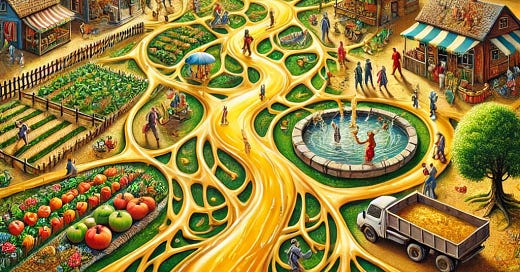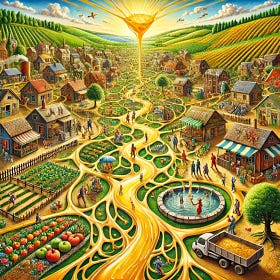Mediating Structures: The Living, Interstitial Tissues of Symbiotic Culture
Dear Symbioties, I wanted to share this after the last post on the Parallel Polis for your consideration. I will get back to my regular chapter post next week.
Mediating Structures: The Living Tissues of Symbiotic Culture
In a world stretched thin between isolated individualism and the impersonal machinery of massive bureaucratic systems, as I’ve said many times, society's renewal will not come from the top down or the lonely individual or group up. Nor will it emerge from the many well-intentioned but siloed networks already doing good work in isolation.
It will emerge from the “middle spaces” of life, where people gather in intentional, face-to-face relationships to cultivate belonging, meaning, and moral formation.
This is the realm of what American sociologist and Protestant theologian Peter Berger called “mediating structures.” Mediating structures are the intermediate institutions that stand between the individual and the vast systems of state and market—families, neighborhoods, faith communities, schools, cooperatives, civic groups, recovery groups, and professional and voluntary associations and networks.
Mediating structures, much like the Parallel Polis:
Emphasize grassroots, voluntary, and human-scale institutions
Resist the dominance of centralized state or corporate systems
Provide space for spiritual, cultural, and ethical revival and renewal
Serve as generative crucibles of civil engagement
At its core, Symbiotic Culture is about strengthening civil society—the network of relationships, associations, and institutions where we participate in public life, build trust, and pursue shared values freely and voluntarily, often outside of profit or government control.
Mediating structures, sometimes called intermediary organizations, play a vital but mainly invisible role. For example, Symbiotic Networks connects and supports more formal organizations and enterprises that provide goods and services while not directly delivering those goods and services themselves.
Instead, they serve as relational bridges and organizing frameworks, helping people and organizations unite, coordinate efforts, and sustain a culture of mutual care and responsibility.
These institutions are where virtue is practiced, trust is formed, and collective or nexus agency becomes real.
Berger described them as the essential scaffolding of a healthy society, allowing people to act meaningfully in the public sphere without being absorbed or erased by large systems.
Thinkers across centuries and cultures have echoed this view. Edmund Burke called them “little platoons”—the first circles, starting with family and neighborhood, of belonging that shape our moral and “political” identity. Alexis de Tocqueville praised voluntary associations as the backbone of American democracy, where people learn to practice civic virtue and hold the state accountable.
In After Virtue, Alasdair MacIntyre pointed to small, intentional communities, communities of practice, as the last repositories of moral coherence in an increasingly fragmented world. In A Secular Age, Charles Taylor highlighted the vital role of middle spaces where meaning-making and moral imagination can flourish outside the pressure of ideological conformity.
This thread of wisdom is not just theoretical. It comes alive in examples like Nobel Prize winner Elinor Ostrom’s research on local communities managing shared resources without top-down control. It pulses through the Sarvodaya Societies, the recovery groups of Alcoholics Anonymous, house churches, the mutual aid groups reclaiming economic agency, and, of course, the Parallel Polis that built independent civic structures as a form of cultural resistance that led to new institutional formation in Communist Czechoslovakia.
As I have mentioned previously, this vision also finds profound resonance in Catholic Social Teaching, especially in the principle of subsidiarity, which insists that larger systems should never displace local, human-scale institutions but support them. Vatican documents like Quadragesimo Anno and Centesimus Annus affirm that the person's dignity (being made in the Image of God ) is most fully realized through participation in intermediate associations—not isolation nor dependency.
Symbiotic Culture arises precisely as a mediating structure through the renewal and weaving of all other mediating structures in a local region.
These relational, participatory spaces hold Symbiotic Culture’s Five Stages of Practice together—from personal transformation to social, cultural, economic, and political coherence.
They are not peripheral to the work; they are the work.
They are where people don’t just talk about community—they live it.
Mediating structures are not optional in today’s collapsing systems and fractured social trust – they are imperative. They are the living interstitial tissues of a Symbiotic Society—flexible enough to adapt and rooted enough to endure. As we reimagine what it means to love, build, and belong, they remain our most vital places of practice.
That’s why building bridges between siloed networks is essential, alongside the many incredible efforts already taking place.
It’s less about creating a new project and more about paving the road, the living interstitial tissues of Symbiotic Culture—a superhighway of Love—that can lift all boats, including the siloed efforts themselves.
Connection doesn’t diminish the work of networked silos; it amplifies it!
Feel free to reply to this email.
Get up to speed on my book, Birthing the Symbiotic Age.
Recent Chapter 12 posts:
Living in Truth: Building a Parallel Polis Within a Spiritually Hostile Regime
The Ancient Blueprint – A Missing Piece Hiding in Plain Sight
I Write the Book, the Book Writes Me
Building Bridges to a New World
Dear Fellow Symbiotes, I have received many requests to share background on the Symbiotic Culture approach.
embodying the Transcendent through the nodes of intersection within local, grassroots-empowered community networks.








I've read that cultures should be treated as living things, that have an arc of health and unhealth, but must be actively maintained, and I agree